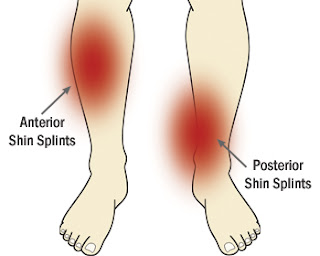I'm happy to say that shin splints have never been a problem for me. I have, however, heard many runners complain about them. Since I'm all about injury prevention these days, I'm making an effort to not only avoid repeating injuries I've already experienced, but also to take preventative measures for those that haven't cursed me yet. A recent newsletter update from Dr. Ray McClanahan, one of my Minimalist Monday running instructors, brought shin splints to my attention. So far, they seem like an easy one to both prevent and treat.
The causes of shin splints vary. They can be a side effect of stress fractures or weak arches, but according to Doc Ray, two causes are most common and often come as a pair:
- Increasing running distance/frequency too quickly.
- Improper footwear.
In this case, as in many cases, "improper footwear" means specifically elevated heels and toe springs, but the usual tapered toe boxes, arch supports and rigid soles seem to contribute as well. The idea is that these features create an unnatural mechanical imbalance in the muscles that lead to the injury, and this concept is starting to feel very familiar to me. The more I learn about running injuries, the more I learn about how all of these conventional shoe features work together to increase their likelihood and the better I feel about my decision to go barefoot/minimal.
At my recent running workshop with Michael Sandler (author of Barefoot Running and the recently released Barefoot Walking), the connection between shin splints and conventional shoes was addressed. Just as I was trying to recall what Michael said on the subject, Doc Ray's people posted this video showing that exact portion of his speech, preceded by the good doctor's explanation:
Incidentally, I'm the funny-looking guy with the rolled-up jeans on the left.
The good news is that shin splints often aren't very serious and can usually be treated easily at home. Here are Doc Ray's recommendations for immediate treatment and long-term prevention:
Immediate Treatment:
Long-Term Prevention:
So, if you increase your running at a reasonable rate and go barefoot or wear minimalist shoes, will shin splints be eradicated from your life? Since they were never a regular problem for me, I don't have the real-world experience to say for sure. I will say that if you find them to be a recurring problem, that may be a strong sign that something needs to change. In other words, don't expect shin splints to simply heal and never return if you continue to run the same way on the same training plan.
Immediate Treatment:
- Rest.
- Elevation of your affected leg.
- Ice application (15 minutes on, 15 minutes off) for 24 to 48 hours.
- Achilles tendon and anterior lower leg muscle stretching.
- Taping procedures.
Long-Term Prevention:
- Ankle and calf strengthening exercises.
- Proper shoe selection and use.
- Toe splay, as enabled with the use of Correct Toes toe-spacers. This encourages a lower-impact gait pattern, which in turn reduces stress to your periosteum.
- Various leg and calf stretches before and after physical activity.
- A proper training plan.
So, if you increase your running at a reasonable rate and go barefoot or wear minimalist shoes, will shin splints be eradicated from your life? Since they were never a regular problem for me, I don't have the real-world experience to say for sure. I will say that if you find them to be a recurring problem, that may be a strong sign that something needs to change. In other words, don't expect shin splints to simply heal and never return if you continue to run the same way on the same training plan.
Any thoughts on this?



0 comments:
Post a Comment